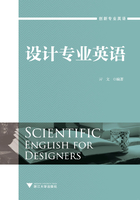
2.1.5 动词
在英语中表示人或事物行为和状态的词叫动词。按动词在句中的作用,英语动词可分为行为动词(实义动词)、系动词、助动词和情态动词等。下面主要针对专业英语中动词的一些特殊情形进行分析。
1.系动词
英语中有一定数量的系动词。它们通常是由其他动词演变成的。常见的系动词有remain, stay, go, prove, seem, appear, look, sound, get, turn等。这些系动词通常紧跟形容词形成复合谓语。
例句1:This result looks unreasonable.
译文:这个结果看起来不合理。
例句2:In this case the input goes high while the output stays low.
译文:在这种情况下,输入走高,而输出走低。
2.半助动词
英语中有一定数量的半助动词,常见的有appear, seem, happen, prove, turn out等。通常这些半助动词后面紧跟动词不定式形成复合谓语。
例句1:In the universe, there appear to be only two kinds of charge.
译文:宇宙中电荷似乎只有两种。
例句2:In everyday life, heats seem to be transmitted by“direct contact”.
译文:在日常生活中,热似乎是靠“直接接触”来传递的。
3.代动词
英语中只有一个“do(does, did)”作为代动词,代动词主要是用在比较以及方式状语从句中,可代替前面出现过的实义动词及附属部分。
例句1:Silver conducts electricity better than gold does.
例句2:In general, gases expand and contract as liquids do.
例句3:An electric lamp produces much less light than it does heat.
例句4:Most smart phones continue to protect their physical machine far better than they do their data.